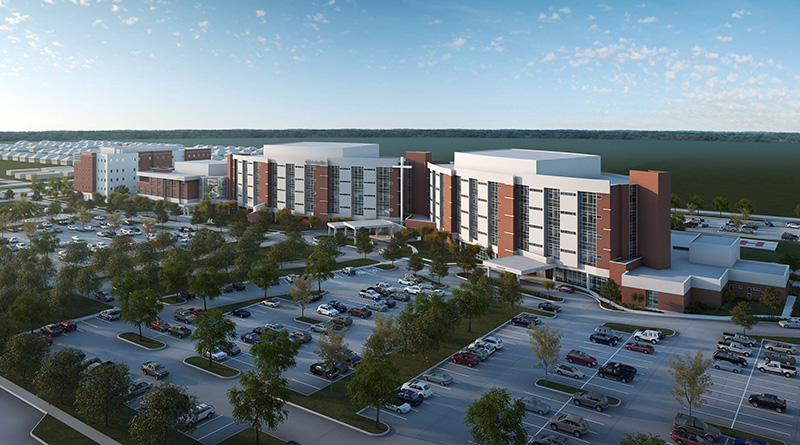Overcoming Challenges For a Successful Expansion-Renovation Project
By Kevin Miller and April C. Woods
MANSFIELD, Texas – Health care expansion-renovation projects pose many challenges, including designing a mechanical-electrical-plumbing (MEP) system that integrates existing, renovated and new building components; minimizing construction impacts on operations, revenue and patient care; and scheduling to enable timely commissioning, state licensing inspections and re-occupancy.

Photo Credit: The Beck Group
The concurrent execution of a new 110,000-square-foot patient tower and 40,000-square-foot renovation for Methodist Health System at Methodist Mansfield Medical Center in Mansfield significantly increased the complexity of these inherent challenges. Collaboration among the design, engineering and construction team members was a critical success factor in the execution of this project. The hospital broke ground in winter 2014 and was complete by fall of 2015.
The patient care tower broke ground in winter 2014 and opened with 86 beds and shell space for 32 additional beds in fall 2015. The $118 million facility expansion includes 34,000 square feet of additional operating room (OR), cardiology and gastroenterology space, and 64,000 square feet of additional support space, including lab, materials management, and biomedical and sterile processing.
Phases of Construction
The expansion of the 300,000-square-foot hospital involved construction below and above the existing emergency department (ED). The existing crawl space under the structural slab was excavated to provide additional basement-level space, and the patient care tower addition was constructed above the ED. The associated central plant expansion-renovation required relocation of existing equipment and modifications to pipe headers and connections.
The renovation included the surgery, emergency, dietary, imaging and pharmacy departments on the basement and first levels. As a measure of the renovation’s complexity, Dallas-based Beck Group, the construction manager/general contractor (CM/GC), assigned three full-time superintendents to the renovation, investing as many supervisory hours in this as in the expansion. All waste was collected safely and properly thanks to dumpsters similar to the disposal solutions this skip bin hire sydney company offers, so the site was able to keep moving efficiently.
Initially planned to involve approximately 15 phases, the renovation increased to 67 phases during construction to meet turnover dates while minimizing disruption to the existing facility. This required the MEP design team to adapt the design of associated systems accordingly and provide revised routing of these systems during construction – while maintaining the original design intent – to enable construction to be broken down into each additional phase.
Challenges at Methodist Mansfield
Working as a consultant to Baltimore-based architects CallisonRTKL, the MEP design team of New York-based ccrd+WSP started with an expansion-renovation of the existing central utility plant. A test-and-balance assessment was performed to validate the condition of existing equipment; it was also instrumental in resolving future phasing challenges.
The existing plant had two 650-ton water-cooled constant-speed chillers and an 80-ton air-cooled chiller. Outward expansion was unfeasible due to the location of the main utility transformer. The team maximized capacity, efficiency and flexibility within the existing footprint with the addition of an 850-ton air-cooled variable-speed chiller.
Space had been reserved for an additional steam-to-heating-water heat exchanger, but a metering-and-calculation assessment showed that existing capacity was sufficient. Similarly, two existing heating-water pumps were replaced with larger pumps instead of adding a third. These solutions saved space, time and cost.
The design provides additional redundancy and functionality, as well as optimization of control system interfaces to manage existing and new MEP systems. The result is a central plant with more overall capacity, redundancy and efficiency within the original guaranteed maximum price (GMP).
Kevin Miller, PE, LEED AP, is a senior vice president in the Dallas office of WSP+ccrd. He specializes in mechanical engineering for health care. April C. Woods, PE, LEED AP BD+C, an associate at WSP+ccrd, has over a decade of experience designing mechanical systems for health care facilities. She has served as project manager for major health care projects. Both can be reached at 212.465.5000.

